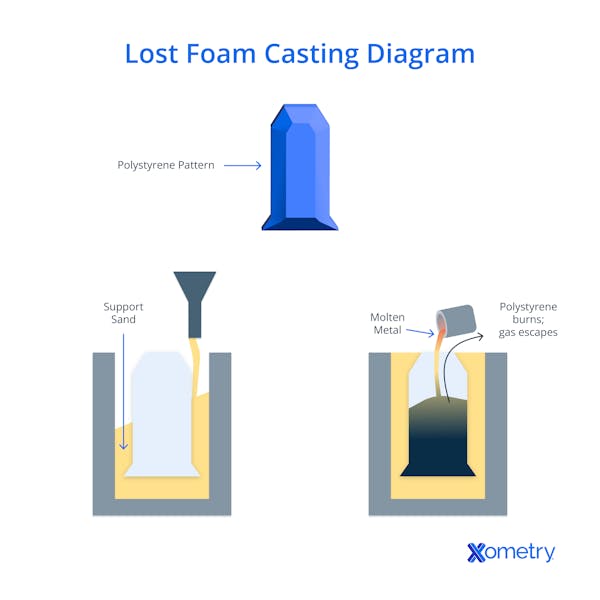Just How Aluminum Foundry Adds To Innovations in Aerospace Design
Aluminum foundries are indispensable to innovations in aerospace engineering. They create light-weight, high-strength elements that are essential for contemporary aircraft. Via sophisticated casting methods, these shops create complicated geometries that enhance structural honesty. In addition, the growth of exceptional Aluminum alloys sustains the market's emphasis on fuel performance and sustainability. Nevertheless, challenges stay in the production procedure. Understanding these elements discloses the extensive influence of Aluminum on aviation's future.
The Value of Lightweight Products in Aerospace Style
As the aerospace sector continues to advance, the importance of lightweight products comes to be progressively noticeable. The demand for effectiveness and sustainability drives designers to prioritize making use of materials that lower overall weight without compromising structural honesty. Light-weight materials, especially Aluminum, play a necessary role in enhancing fuel efficiency, improving haul capability, and raising the total efficiency of aircraft.
The assimilation of these materials enables for cutting-edge styles, making it possible for makers to develop more aerodynamic shapes that can withstand severe conditions. The decrease in weight not just decreases operational expenses however likewise adds to a lowered ecological footprint, straightening with international initiatives towards sustainability in air travel.
Advanced Spreading Techniques in Aluminum Foundries
Advanced spreading methods in Aluminum factories play an important function in aerospace engineering by enabling the production of lightweight and accurate parts. Developments in mold layout and precision spreading processes are crucial in accomplishing optimal efficiency and structural integrity. Additionally, the advancement of light-weight alloys improves the total performance and efficiency of aerospace applications.
Cutting-edge Mold And Mildew Style
Ingenious mold and mildew style plays a necessary function in the efficiency and efficiency of Aluminum factories, especially within the aerospace market. By leveraging advanced products and methods, modern molds can be crafted to stand up to high temperatures and pressures, making certain peak efficiency during the casting procedure. These designs commonly include complex geometries that permit the manufacturing of lightweight yet structurally sound components, vital for aerospace applications. Additionally, the use of computer-aided style (CAD) software promotes specific modeling, enabling foundries to fine-tune and replicate mold styles before physical manufacturing starts. This not only boosts the quality of actors components however also minimizes waste and preparation, leading to substantial cost savings. In general, ingenious mold layout is a cornerstone of development in Aluminum Foundry modern technology for aerospace engineering.
Precision Casting Processes
The performance of ingenious mold layouts perfectly incorporates with precision casting procedures, which are vital for creating high-grade Aluminum elements in aerospace design. These processes, consisting of sand spreading, pass away casting, and financial investment casting, ensure the creation of complex geometries with tight tolerances. Advanced methods like vacuum cleaner spreading and pressure pass away casting improve the honesty and surface coating of the last items. Precision spreading decreases product waste while making the most of the mechanical residential or commercial properties of Aluminum, important for aerospace applications. Additionally, utilizing real-time surveillance and advanced simulation devices during the casting process permits immediate changes, causing enhanced high quality control. Collectively, these precision casting processes position Aluminum factories at the forefront of aerospace innovation, sustaining the sector's need for dependability and performance.
Light-weight Alloy Growth
As aerospace designers look for to boost gas efficiency and performance, light-weight alloy growth ends up being a crucial emphasis in Aluminum foundries. These shops use sophisticated spreading strategies to create alloys that offer exceptional strength-to-weight proportions. Innovations in alloy structure, including the incorporation of elements like lithium and magnesium, enable the production of products that hold up against severe problems while decreasing general aircraft weight. Techniques such as die spreading and investment casting facilitate the precision manufacturing of complicated forms, which are essential for aerospace applications. Furthermore, ongoing study aims to enhance these alloys for boosted mechanical homes and raised toughness. By prioritizing light-weight alloy development, Aluminum foundries considerably add to the evolution of aerospace design, leading the way for much more reliable and lasting airplane styles.

Enhancing Architectural Honesty Through Aluminum Components
Aluminum elements supply significant benefits in boosting structural honesty within aerospace engineering. Their lightweight nature adds to total performance while maintaining toughness, which is important for aircraft performance. Furthermore, the anxiety resistance residential or commercial properties of Aluminum assistance assure the resilience and integrity of aerospace structures under different operational conditions.
Lightweight Product Benefits
While conventional materials usually compromise weight for toughness, making use of Aluminum parts in aerospace design uses considerable benefits in architectural integrity. Aluminum's lightweight nature adds to overall design efficiency, enabling for more streamlined airplane that eat much less fuel, consequently improving sustainability. The product's excellent strength-to-weight ratio guarantees that parts maintain toughness without adding unneeded mass. This high quality cultivates enhanced efficiency and dexterity in flight, along with maximized haul capabilities. Furthermore, Aluminum's resistance to corrosion lengthens the life-span of aerospace frameworks, lowering upkeep costs and boosting security. As manufacturers progressively adopt Aluminum alloys, the aerospace sector experiences a transformative shift towards much more effective and effective engineering options that prioritize both efficiency and ecological obligation.
Stress Resistance Features
Different products possess unique residential or commercial properties, Aluminum's extraordinary tension resistance stands out as an important element in boosting the structural integrity of aerospace elements. This resistance plays an essential role in making sure that airplane can withstand various functional anxieties, including tiredness, effect, and ecological problems. Aluminum alloys, especially crafted for aerospace applications, show high tensile strength while preserving lightweight qualities, enabling designers to create more efficient frameworks - Aluminum Foundry. Additionally, the capacity of Aluminum to withstand cyclic loading without substantial deformation adds to the durability and integrity of aerospace components. As advancements proceed in Aluminum Foundry methods, the development of stress-resistant Aluminum parts guarantees additional renovations in efficiency, safety, and efficiency across the aerospace industry, solidifying Aluminum's function as a preferred product in modern engineering
Fuel Effectiveness Improvements Driven by Aluminum Innovations
As the aerospace sector seeks to improve fuel efficiency, ingenious usages of Aluminum have actually arised as an essential solution. Aluminum's lightweight nature especially lowers aircraft weight, allowing for lower more helpful hints gas usage during flight. This decrease in weight is crucial, as also tiny decreases can bring about substantial renovations in general gas economic situation.
Advanced Aluminum alloys, created for enhanced toughness and resilience, make it possible for makers to produce parts that preserve architectural integrity while lessening mass - Aluminum Foundry. Additionally, the assimilation of Aluminum in airframes and engine elements promotes enhanced aerodynamics, adding to minimized drag and enhanced performance
The adoption of Aluminum in aerospace not only fulfills the demand for fuel-efficient style however likewise aligns with regulative stress for lower discharges. As these developments proceed to develop, they play a substantial function in establishing brand-new criteria for gas efficiency, making certain that the aerospace industry can meet expanding ecological and economic difficulties.

The Function of Aluminum in Sustainable Aviation Practices
The enhancing focus on lasting air travel practices has positioned Aluminum as an important material in the mission for greener airplane design. Recognized for its lightweight buildings, Aluminum substantially lowers aircraft weight, leading to lower gas consumption and discharges. Its recyclability better improves its sustainability profile, as Aluminum can be reused indefinitely without loss of high quality. This particular sustains a round economy within the air travel industry, lessening waste and resource depletion.
In addition, improvements in Aluminum alloys have boosted their toughness and rust resistance, enabling longer solution life and minimized upkeep needs. These developments assist in the advancement of much more effective airplane frameworks, adding to overall sustainability initiatives. Furthermore, Aluminum's thermal conductivity plays an essential function in energy-efficient designs, improving systems such as warm exchangers. Jointly, these characteristics highlight Aluminum's pivotal duty in progressing sustainable air travel, straightening with international campaigns aimed at decreasing the ecological impact of flight.
Difficulties Encountered by Aluminum Foundries in Aerospace Manufacturing
While Aluminum factories play an important role in aerospace production, they encounter considerable challenges that can influence production performance and top quality. One major challenge is the rigorous quality control criteria needed in the aerospace industry. Any problem can jeopardize safety and security and efficiency, demanding rigorous examination processes that prolong manufacturing timelines. Additionally, factories frequently emulate varying basic material prices, which can affect rates and profitability. The intricacy of Aluminum alloys used in aerospace applications further complicates the production procedure, as precise formulas are crucial for achieving desired mechanical properties. Competent labor lacks impede the capability to preserve top notch manufacturing degrees. Ultimately, environmental regulations impose restrictions on emissions and waste administration, calling for shops to invest in lasting methods, which can be cost-prohibitive. These elements jointly develop a landscape where Aluminum factories should continuously adjust to satisfy the evolving needs of aerospace manufacturing while guaranteeing security and compliance.
Future Trends in Aluminum Applications for Aerospace Engineering
With innovations in modern technology and boosting demands for efficiency, the future of Aluminum applications in aerospace design is poised for substantial makeover. The combination of ingenious Aluminum alloys and compounds is anticipated to enhance strength-to-weight proportions, resulting in more fuel-efficient airplane designs. On top of that, improvements in additive production techniques will allow for the manufacturing of complex Aluminum structures that were previously impossible, enhancing efficiency and reducing waste.

Sustainable methods will certainly play an important role, with a growing emphasis Learn More on recycling Aluminum to reduce ecological influence. The aerospace his response sector is likely to embrace smarter producing procedures, such as automation and expert system, ensuring higher quality and precision in Aluminum elements. Additionally, cooperations in between Aluminum shops and aerospace companies will foster research study and growth, leading the means for new applications that meet the strict demands of contemporary aerospace engineering - Aluminum Foundry. Overall, the future looks promising for Aluminum's function fit the skies
Regularly Asked Concerns
What Are the Ecological Impacts of Aluminum Manufacturing in Aerospace?
The environmental effects of Aluminum manufacturing in aerospace consist of substantial power intake, greenhouse gas exhausts, and environment interruption. Additionally, mining procedures can bring about soil destruction and water contamination, raising problems about sustainability and ecological balance.
Just How Does Aluminum Compare to Other Products in Aerospace Applications?
Aluminum provides an one-of-a-kind combination of lightweight buildings, deterioration resistance, and cost-effectiveness contrasted to various other products. Its high strength-to-weight proportion makes it specifically advantageous for aerospace applications, enhancing gas performance and general performance in aircraft layout.
What Certifications Do Aluminum Foundry Workers Demand for Aerospace Projects?
Aluminum Foundry workers call for specialized training in metallurgy and casting methods, along with understanding of aerospace industry criteria. Qualifications in quality control and security methods are likewise important to guarantee conformity with stringent aerospace job requirements.
Exist Any Type Of Safety Issues With Using Aluminum in Aerospace Design?
Security problems relating to Aluminum in aerospace design include susceptibility to stress and anxiety, exhaustion, and deterioration fractures. Correct treatment and alloy choice are necessary to reduce these threats, making sure architectural integrity and general safety and security in aerospace applications.
Just How Does Aluminum Recycling Advantage the Aerospace Industry?
Aluminum reusing substantially benefits the aerospace market by minimizing material costs, minimizing environmental impact, and conserving energy. This sustainable practice enhances the industry's effectiveness while advertising using lightweight, high-performance elements in aircraft production.
Advanced casting strategies in Aluminum shops play an essential duty in aerospace design by enabling the production of accurate and lightweight components. Innovative mold layout plays a crucial duty in the performance and efficiency of Aluminum factories, especially within the aerospace industry. As aerospace engineers look for to improve fuel efficiency and efficiency, lightweight alloy development comes to be a necessary focus in Aluminum shops. Aluminum alloys, specifically engineered for aerospace applications, display high tensile strength while keeping lightweight qualities, enabling designers to design extra effective structures. Cooperations between Aluminum foundries and aerospace firms will cultivate research study and development, leading the way for brand-new applications that meet the rigorous demands of modern aerospace design.